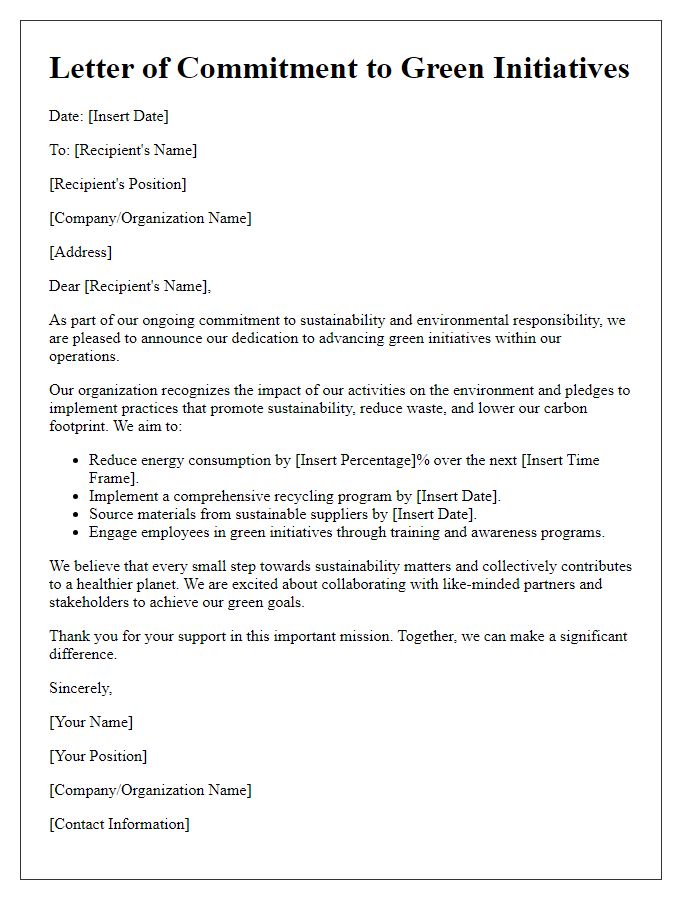Are you ready to make a difference in our fight for a healthier planet? Crafting a letter for an environmental sustainability pledge is a powerful way to express your commitment to protecting our environment and inspiring others to join the cause. In this article, we'll explore how to effectively communicate your dedication to sustainability through a thoughtful and impactful letter. So, let's dive in and discover how you can inspire change with your message!

Commitment to sustainable practices
In recent years, the global focus on environmental sustainability has intensified, driving communities, organizations, and individuals to adopt eco-friendly practices. For instance, initiatives such as the Global Climate Strike, which saw millions participate in protests worldwide each September, highlight the urgent need for actionable commitments. Many cities, including San Francisco and Copenhagen, have implemented zero waste policies aiming for a circular economy where no resources go to waste. Organizations like the United Nations have emphasized sustainable development goals, with particular attention on reducing carbon emissions by 50% by 2030. The shift toward renewable energy sources, such as solar and wind, has gained momentum, particularly in states like California and Texas, making them leaders in sustainable energy production. These efforts reflect a broader commitment to protecting ecosystems and ensuring a healthier planet for future generations.
Specific environmental goals and targets
The commitment to environmental sustainability involves defining specific environmental goals and targets that can drive impactful change. For instance, a pledge could include reducing carbon emissions by 30% by the year 2030, in line with the Paris Agreement's climate objectives to limit global warming to below 1.5 degrees Celsius. Implementation of renewable energy sources, such as solar and wind, could aim to achieve 50% of the energy needs by 2025, contributing to a reduction in reliance on fossil fuels. Additionally, a commitment to decreasing waste generation by 40% through comprehensive recycling programs and the adoption of a circular economy model could be established. Furthermore, enhancing biodiversity through initiatives like planting 10,000 trees by 2024 in urban areas can support local ecosystems. Monitoring progress towards these targets through annual sustainability reports will ensure transparency and accountability in achieving these environmental goals.
Engagement and collaboration with stakeholders
Engagement and collaboration with stakeholders play crucial roles in advancing environmental sustainability initiatives. Effective partnerships among local governments, businesses, non-profit organizations, and community members can significantly enhance resource efficiency and promote eco-friendly practices. Strategic dialogues during community forums, such as the annual Earth Day events celebrated in cities globally, foster awareness and accountability. Collaborative projects, particularly those focused on renewable energy sources like solar and wind, can lead to reduced carbon footprints. Implementing sustainable practices in industries, such as the textile sector, helps mitigate pollution and conserve water, while engaging consumers in eco-conscious choices encourages community participation. Regular workshops and training programs can educate stakeholders on the importance of sustainable practices, empowering them to make informed decisions for a healthier planet.
Monitoring and reporting systems
Effective monitoring and reporting systems play a crucial role in advancing environmental sustainability initiatives, particularly in corporate and governmental organizations. These systems collect data regarding resource usage, emissions levels, and overall ecological impact across various sectors. For instance, companies can utilize platforms like the Global Reporting Initiative (GRI) to analyze sustainability metrics, leading to informed decision-making processes. Additionally, local governments can implement real-time air quality monitoring tools, such as low-cost sensors, to assess pollution levels in urban areas like Los Angeles or Beijing. Regular reports generated by these systems not only enhance transparency but also foster accountability among stakeholders, encouraging actions aligned with global sustainability goals, such as the United Nations' Sustainable Development Goals and the Paris Agreement objectives. Utilizing advanced technologies like satellite imaging and blockchain can further improve data accuracy and traceability, creating a comprehensive overview of environmental performance and progress.
Education and awareness initiatives
Environmental sustainability initiatives play a crucial role in fostering awareness and promoting responsible practices among communities. Organizations often implement education programs (targeting schools, local groups, and businesses) that inform individuals about the importance of conservation efforts such as recycling, waste reduction, and sustainable resource management. Workshops and seminars are commonly hosted, allowing participants to engage with experts on topics like climate change impacts, renewable energy sources, and biodiversity preservation. Educational materials, including pamphlets and digital resources, are disseminated to enhance understanding and facilitate eco-friendly behaviors. These initiatives aim to inspire a collective commitment to protecting the planet for future generations, encouraging actions such as reducing carbon footprints and supporting local conservation projects.













Comments